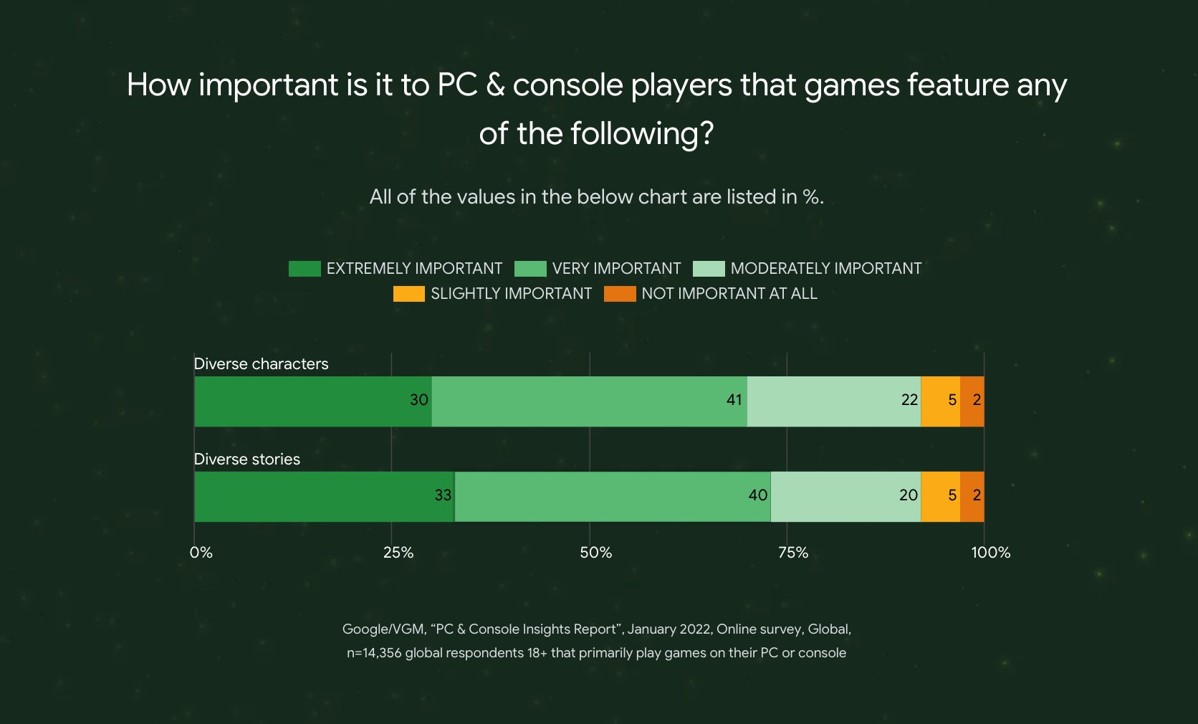PRODUCT INCLUSION ACTION
Help Customers Feel Seen

Incorporate stories and themes from marginalized communities or emerging markets in a relatable way.
Customer Challenge
Having your story told is a universal human need, but for many in marginalized communities or in markets outside of the US, it's rare to be represented in media, let alone games, and as a result, some people could feel like a secondary consumer for our content.
Business Impact
80% of media consumed by the world is created in the US* and yet most media, including video games, don't contain characters and content that align to that broad consumer.
Research shows that players prefer to play characters that look like them and are more likely to purchase and play experiences where they align to the characters identity.
- 57% of players in the broader gaming market didn't play certain games because the games weren't made for them. Over half of the global gaming market.
- 53% of developers felt diversity in storytelling should be a priority and it was ranked as the third most important factor in industry growth.
- 41% of retail consumers have shifted 10% or more of their business away from brands that do not reflect their value in diversity & inclusion.
References: New Zoo 2022 DEI Study, Diamond Lobby Diversity in Gaming Report, Newzoo 2023 Global Gamer Study; Gina Davis Institute

Source: 2022 Google PC & Console Insights Report
Questions to Consider
- Are you telling new stories or sharing new perspectives within the product experience?
- Do all of your characters/player depictions look the same?
- What steps have you taken to ensure characters are represented respectfully and authentically?
- How have you validated assumptions you have made about your audience to check for blind spots or unintended stereotypes?
- Would you feel proud to show a member of a community how their culture/character is depicted within your experience?
- How are the wide range of customers depicted within your products, content portfolio and communications?
- What process have you used to validate how different groups of people or cultures are represented in your experience?
- Are you reinforcing any negative gender stereotypes?
- Are you unnecessarily introducing gender & gender barriers into your code or design?
- Are you creating playable female characters that are equal in skill and ability to their male peers. Are your female characters equipped with clothing and armor that fits their tasks? Do they have exaggerated body proportions?
- When the story allows, do you show male characters who display a full range of emotions, including joy, sadness, and vulnerability?
- Are you unnecessarily introducing gender & gender barriers into your code or design?
- What % of screen time (on screen presence, speaking lines, heroes) is held by different gender/racial identities?
- Do you have a process to review key decisions with the lens of Helping Customers Feel Seen?
Steps to Achieve It
1. Set Goals for what you want to achieve & share them with your project members
- Do planning at the start of projects to identify opportunities & obstacles.
- Go through the 10 Product Inclusion actions to bring intentionality into your designs.
2. Identify & Utilize resources to help drive success
- Co-Create your experience with the community to ensure that you are creating experiences that are relatable.
- Leverage inclusive Listening systems to ensure that what you are creating is relatable.
3. Create & surface content that depicts diverse characters, stories and creators
- Create playable characters that reflect the broader population. Review how identities represented on screen (gender identities, races, sexual orientations, ability status, ages, and body sizes) match up to the broader population. Make sure that characters are not tokenized or stereotyped based on their identities.
- Review how identities represented in your product such as gender, race, sexuality, nationality, cultural, ability, age, and size compare to the broader global player population. Be intentional about which identities are present and highlighted according to what’s right for your product and market.
- Make sure that characters are not tokenized or stereotyped based on their identities. No person or character can be a monolith to represent all people with that identity.
- Practice inclusive casting for any talent required to bring representation to life in your product.
- Validate your execution for your Inclusive Listening Systems (consultants/advisory councils, user research).
